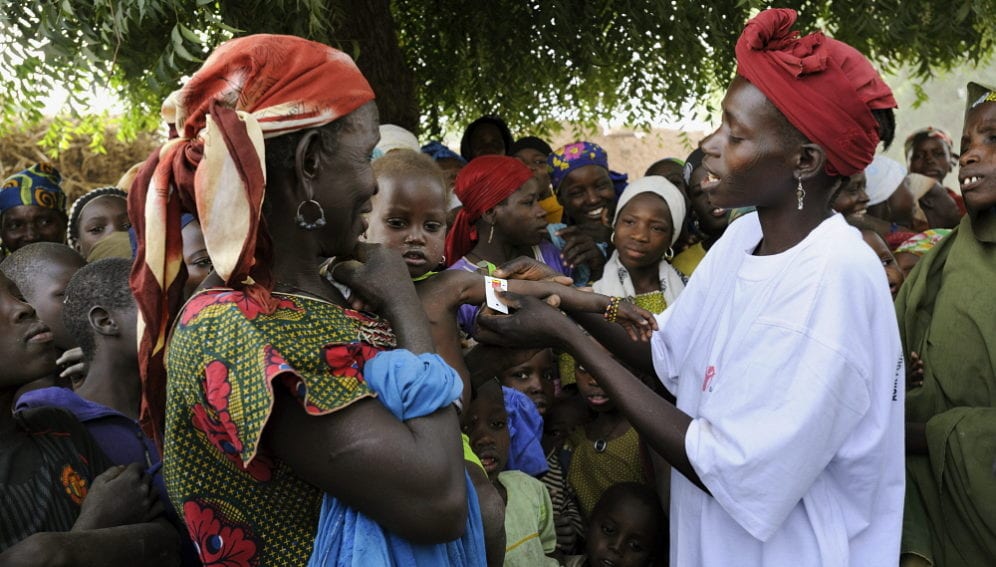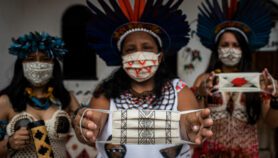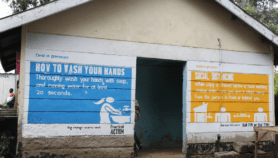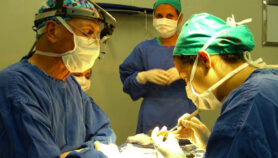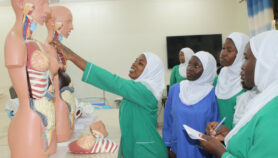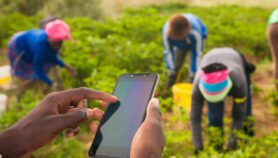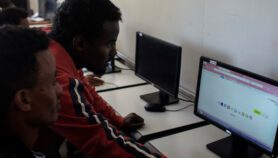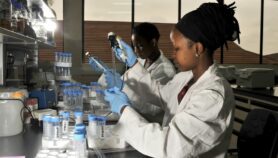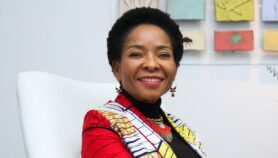By: Obidimma Ezezika
Send to a friend
The details you provide on this page will not be used to send unsolicited email, and will not be sold to a 3rd party. See privacy policy.
How do you build trust with communities involved in your research? Obidimma Ezezika shares tips and experience.
You are about to embark on a research project in a developing country. Perhaps you’re conducting a clinical trial, figuring out the best way to set up a development project, or enlisting farmers to test improved seeds or other new technologies.
- Focus on trust
-
Engage early
-
Listen and learn
-
Get to know your participants
-
Use the right communication methods
-
Get informed consent
-
Communication should not end with the research
How to engage with communities in field research
How well your project goes will depend in large part on how you communicate with the research participants. So where do you start? What communications skills do you need to engage with communities and build trust?
I’ve worked through these questions while conducting research in eight developing countries, and I want to share my experience to help guide you through the essentials of communicating effectively with the people who make your research possible.
Focus on trust
Your aim in communicating effectively with communities is to build mutual trust and improve the buy-in that will sustain your research project, as well as making the experience as beneficial to the community as possible.
If you need convincing that communication is important to your research, think of what happens when it breaks down.
In northern Nigeria we have seen the polio vaccination initiative struggle because community concerns and myths about immunisation have been allowed to perpetuate. This can be put down to community distrust and ineffective engagement by government health officials, especially with religious leaders. [1]
Similarly, in Cambodia researchers abandoned trials of tenofovir, a preventative treatment for HIV, after the project failed to properly consider social and cultural needs when designing the trial. For example, it did not provide adequate consultation with or counselling for the target communities. [2]
Effective engagement takes place when there is two-way communication and mutual trust between the researchers and the community, and when researchers are able to address any concerns or issues that the community might have about the research.
In the Nigerian example, once religious leaders were engaged, and once the widespread perception that immunisation was a secret way of controlling the population could be assuaged, the vaccination programme was able to continue.
Last month a colleague and I wrote a paper in which we argued that focused communication to build and foster trust is more effective than plain delivery of information and awareness creation, which is often the typical strategy of research communication. [3]
Engage early
One way to build trust and understanding with communities is to engage with participants from the earliest opportunity. For example, the African Malaria Network Trust (AMANET), a pan-African nongovernmental organisation that implements malaria vaccine trials in Africa, reaches out to communities before starting a trial so that they get an opportunity to raise any concerns about the research design.
AMANET begins by consulting with government officials and key community stakeholders. The goal is to seek permission and get buy-in from them — because they can support, or alternatively halt or undermine, a project — and hear and address any concerns they may have, before meeting with the wider communities.
“Your aim in communicating effectively with communities is to build mutual trust and improve the buy-in that will sustain your research project, as well as making the experience as beneficial to the community as possible.”
For example, in the case of an AMANET malaria vaccine trial, researchers first consulted officials ranging from representatives of the Ministry of Public Health to the local Mayor. Then they met with village chiefs, elders and community members while local government officials were present. AMANET says such practice helps to establish a rapport with all community members. [4] A community with no sense of ownership for a project may not participate, and at times may protest against it, as in Cambodia’s tenofovir trials.
At such meetings, ask the village leaders to introduce themselves and ask the researchers to explain the proposed study. Consider arranging for a translator to help with the local language.
Make sure that you set aside time for community members and the village heads to ask questions about the proposed study, such as: how will participants be selected; does the community have anything to gain; how long will the project last?
It is usually important to take one or two representatives from the government offices that were initially consulted — their presence can give you more credibility with the community.
Listen and learn
Community participation can improve your research process. Over five years between 2008 and 2013, I, together with colleagues from Canada’s Sandra Rotman Centre, ran an evaluation of the Water Efficient Maize for Africa (WEMA) Project, which is a consortium in Africa that develops drought-tolerant maize for small-scale farmers.
The aim of the evaluation was to identify and address the ethical, social and cultural issues that could arise during the research.
At the beginning we tested our social audit tools with a few WEMA internal stakeholders. Based on their feedback, we revised the tools and piloted them using face-to-face interviews with 26 research participants from the agricultural sector, including farmers in Kenya, Mozambique, South Africa and Tanzania.
“Ask questions rather than making assumptions, and listen rather than preach, particularly when exploring people’s fears and feeling around the research.”
Feedback from the pilot interviews led to further changes in how we conducted our main interviews. [5] These were with 100 different participants representing five countries each year. Their responses also led to changes in the WEMA research. For example, after speaking to farmers who wanted many traits in their seeds, multi-trait varieties were produced for testing.
Get to know your participants
Once you’ve selected your participants, you must get to know them. This doesn’t mean getting to know them as individuals, but it does mean getting to know enough about their perceptions to inform how best to communicate with them. Considerations such as how well they understand the topic you’re researching, what their expectations might be, and the cultural and social contexts in which they live are important.
When doing this, it is important to seek to genuinely understand the community’s culture. Ask questions rather than making assumptions, and listen rather than preach, particularly when exploring people’s fears and feeling around the research. If you allow misinformation and fear to flourish, the community will be unlikely to engage with your research.
The best way to get to know your participants is to spend time in the community and liaise with local institutions, such as research institutions based around the communities where you want to carry out the research.
During the WEMA project, for example, we held focus groups to gather farmers’ views on the research. We asked the community about their concerns, and people brought up issues such as the need for smaller-scale seed companies to be involved in selling and distributing new maize varieties, and for maize seeds to be not only drought-tolerant but also insect-resistant. The WEMA researchers were able to respond to these issues and address them in the following year of the project.
“The best way to get to know your participants is to spend time in the community and liaise with local institutions”
Depending on the scale of your project and the size of the community, you might want to formalise your liaisons with local organisations and make them a part of the project. However, it is important to ensure that whichever organisation you liaise with has good standing with the community and a good track record. Additionally, hiring local hands is important to help you really understand the community and conduct your research effectively.
When I go into a village I’m not familiar with, I ensure that I have a driver or travel guide who speaks the local language and I go with a local translator. Sometimes I contact other partner organisations who provide me with someone from the community who can help me understand the local context, meet with the village heads and community members and find my way around the government offices. It is best to set up this structure before your research begins.
Use the right communication methods
The language you use to communicate is crucial, as is the channel you use to deliver information. For example, in a country where many languages are spoken, someone may understand the main language, but be much more comfortable and understand more about the research if discussion is in their local language. And if people can’t read, printed information won’t inform them.
Tailor your communication strategy to each project. You might find that you need to convey information in more than one language, or change it depending on the participants (one reason it’s important to get to know them).
We saw the need for this in a farmer engagement project for genetically modified Bt cotton in some communities in Burkina Faso. We were examining the role of trust in the effectiveness of agricultural public-private partnerships in Africa by exploring how they engage with farmers and communities. [6]
While French is the official language in Burkina Faso, many individuals speak ethnic languages as well – such as Jula, Mooré, and Gulmacema. Moreover, Burkina Faso has an adult literacy rate of about 29 per cent, rendering written information useless to a large group of people. Despite these language barriers, the Bt cotton project was able to inform most farmers about the project using a multi-lingual, multi-media approach including translating communication documents into local languages and using newspapers, but also demonstration seminars, radio advertisements, television promotions and films.
Informed consent
There will, of course, be times when you are informing the community about aspects of the research. Communities cannot be involved in making all decisions. In these cases transparency is key: communicate to participants and end-users what the research involves, and whether and how they will benefit. Listen to their concerns and answer any questions.
“It is important to get informed consent well in advance of your research so potential participants have ample time to review the project’s goals and get back to you with any questions.”
In Soweto, South Africa, small-scale farmers I wanted to interview were eager to meet with me because they thought I was from the South African government and I could give them seeds to plant. However, I had to explain that I really had nothing to give them and I had no influence with the South African government or the private sector. They were disappointed but appreciated my clarity and honesty on the fact that there were no benefits. They have participated in the research every year for five years.
It is important to get informed consent well in advance of your research so potential participants have ample time to review the project’s goals and get back to you with any questions.
Your research participant should be given a consent document written in their own language, or at least in one they understand. If they are illiterate, you can use a translator to make an oral presentation of informed consent information and write in the consent document that this was done (include a summary of what was said). The participant should be given these documents and summaries, in their own language.
I particularly like the Nuffield Council on Bioethics’ chapter on informed consent in their The ethics of research related to healthcare in developing countries report. [7]
Communication should not end with the research
As a researcher, you should aim to maintain an on-going dialogue even when the intervention might have officially come to an end. This applies whatever your topic, whether it be a water purification project, clinical trial or introducing new crop varieties.
“Building trust is fundamental — its presence or absence will determine the effectiveness and sustainability of your research project.”
Part of this is about feeding back the results of the research and informing participants of the knowledge they helped to generate. In some cases it’s also about ensuring that any results of the research can benefit the community.
We saw this with a South African agricultural biotechnology programme developing genetically modified maize. The researchers conducting trials for new seed varieties arranged follow-up visits to farmers so they could respond to any issues and questions and ensure that farmers continued to use the seeds in the right way (by using the right fertiliser, properly spacing the planting, and effective crop rotation, for example).
The farmers I spoke with described this follow-up as a benefit. Reinforcing agronomic practices helps the farmers use the seeds to their best effect, but also helps the researchers ensure their intervention stays on track.
So learning to understand your participants and engaging with them effectively benefits both parties. But building trust is fundamental — its presence or absence will determine the effectiveness and sustainability of your research project.
Obidimma Ezezika is the CEO of the African Centre for Innovation and Leadership Development and an adjunct Lecturer at the Dalla Lana School of Public Health, University of Toronto
References
[1] Ayodele Samuel Jegede What led to the Nigerian boycott of the polio vaccination campaign? PLOS Medicine 2007
[2] Jerome A Singh and Edward J Mills The abandoned trials of pre-exposure prophylaxis for HIV: what went wrong? PLOS Medicine 2005
[3] Obidimma Ezezika and Justin Mabeya Improving communication in agbiotech projects: moving toward a trust- centered paradigm. Journal of Applied Communications 2014 98(1) 38
[4] Aceme Nyika and others Engaging diverse communities participating in clinical trials: case examples from across Africa Malaria Journal 2010
[5] Obidimma Ezezika and others A social audit model for agro-biotechnology initiatives in developing countries: Accounting for ethical, social, cultural, and commercialization issues Journal of Technology Management Innovation 2009
[6] Obidimma Ezezika and others The value of trust in biotech crop development: a case study of Bt cotton in Burkina Faso Agriculture and Food Security 2012
[7] Nuffield Council on Bioethics The ethics of research related to healthcare in developing countries


